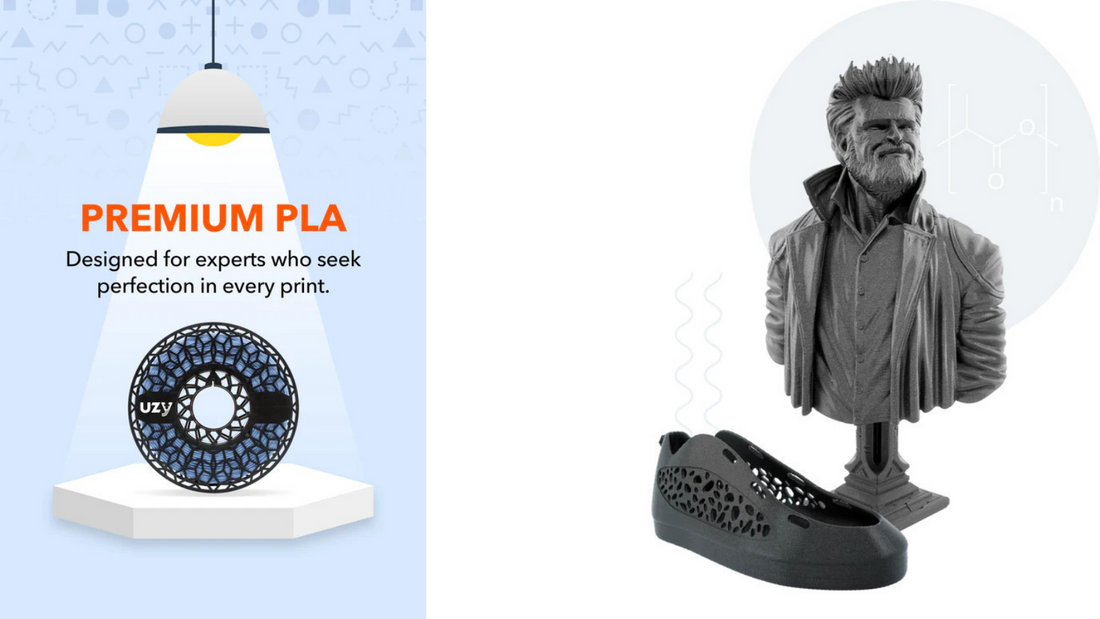What Does PLA Mean in the World of 3D Printing?
If you're new to the world of 3D printing, you may have come across the term "PLA" and wondered what it means. PLA or polylactic acid is a type of plastic filament commonly used in 3D printing. It is known as a sustainable and eco-friendly option as it is produced from renewable resources such as cornstarch or sugarcane.Properties of PLA Filament
PLA is a popular choice for 3D printing because it is easy to print and has a low melting temperature. This means it can be used with most 3D printers and requires less heat to melt the filament and turn it into the desired object. Additionally, PLA has a glossy finish and can be painted in a variety of colors, making it a versatile choice for both functional and aesthetic purposes.However, it is important to note that PLA is not as strong or durable as some other types of filaments. It is not recommended for use in high voltage or high temperature applications as it can become brittle and break easily. It is best suited for low stress, decorative objects or prototypes.
Sustainable Benefits of Using PLA Filament
One of the main advantages of using PLA filament is its sustainability. As mentioned earlier, it is made from renewable resources, which means it has a lower carbon footprint compared to other types of plastics. It is also biodegradable, meaning it can decompose into natural substances over time, reducing its impact on the environment.In addition to its environmental benefits, using PLA filament can also help reduce waste in the manufacturing process. Many companies are turning to 3D printing as a way to create customized and on-demand products rather than mass-producing products that cannot be sold or thrown away. This helps reduce the amount of resources and energy that goes into traditional production methods.
Solution
As a result, PLA is a popular and sustainable choice for 3D printing. It is easy to work with and has a low melting temperature, making it suitable for use with most 3D printers. While not as strong or durable as other filaments, it is low-tension, making it an excellent choice for decorative objects or prototypes. Its sustainability and biodegradability make it an attractive option for companies looking to reduce their environmental impact and waste in the manufacturing process.Why PLA Filament Is The Best Choice For 3D Printing?
If you're a 3D printing enthusiast, you've probably heard of PLA filament. But what makes it the preferred choice for so many people in the 3D printing community?PLA, or polylactic acid, is a type of plastic filament made from renewable resources such as corn starch or sugar cane. It has a low melting temperature and can be used with most 3D printers, making it easy to work with and shape the desired object. It also has a glossy finish and can be painted in a variety of colors, giving it both a functional and aesthetic appeal.
However, perhaps the biggest advantage of using PLA filament is that it is sustainable. It has a lower carbon footprint compared to other types of plastic and is biodegradable, meaning it can turn into natural substances over time. This makes it an attractive choice for those concerned about the environmental impact of their 3D printing projects.
In addition to its sustainability, using PLA filament can also help reduce waste in the manufacturing process. 3D printing allows the creation of customized, on-demand products instead of mass-produced products that cannot be sold or thrown away. This helps conserve resources and energy to be used in traditional production methods.
Of course, PLA filament is not suitable for all applications. It is not as strong or durable as some other types of filaments and is not recommended for use in high voltage or high temperature situations. However, it is an excellent choice for low stress, decorative objects or prototypes.
Solution
In summary, PLA filament is the best choice for 3D printing because of its ease of use, versatility and sustainability. A great option for those who want to create low-stress, decorative objects or prototypes while also minimizing their environmental impact. Whether you are a beginner or a seasoned professional, PLA filament is a reliable and environmentally friendly choice for your 3D printing projects.The Importance of Bed Temperature When Printing with PLA Filament
PLA, or polylactic acid, is a popular choice for 3D printing because of its ease of use and sustainability. However, achieving the best results with PLA requires attention to a number of factors, including bed temperature.Why is Bed Temperature Important?
Bed temperature plays a crucial role in the success of your 3D printing projects. It helps ensure that the first layer of the print adheres properly to the bed and creates a solid foundation for the rest of the object. If the bed temperature is too low, the PLA filament may not adhere properly, resulting in poor adhesion and unsuccessful printing. On the other hand, if the bed temperature is too high, the filament may become too soft and deteriorate, resulting in poor print quality.The ideal bed temperature for PLA filament printing will depend on a number of factors, including the particular type of PLA used, the size and shape of the object being printed, and the ambient temperature in the room. In general, a bed temperature of around 60-70°C is a good starting point for PLA prints, but some people may find they need to adjust it up or down depending on their particular situation.
Tips for Reaching the Right Bed Temperature
Here are a few tips for getting the right bed temperature when printing with PLA filament:- Start with a clean, flat bed: Before you start printing, make sure your bed is clean and level. This will help ensure proper adhesion of the first layer and reduce the risk of warping or poor adhesion.
- Use a mattress adhesive: A mattress adhesive such as blue paint tape or hairspray can help improve adhesion and reduce the risk of warping. Make sure to use a thin, even layer and avoid applying too much as this can result in poor print quality.
- Adjust the bed temperature as needed: If you are having trouble sticking or warping, try adjusting the bed temperature up or down in small increments until you find the best sweet spot for your printer and the particular PLA filament you are using.

